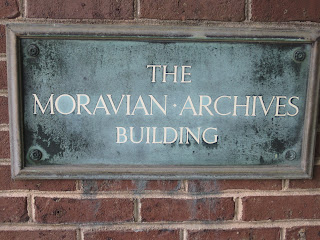Because we did not have the blog site up and running before some of our student staff moved on (graduated!), we asked them to write essays that discussed their experiences at the Moravian Church Archives. To follow are some of the highlights-
Beyond the books themselves, I was also interested in the provenance and other inscriptions on the books. In particular I enjoyed looking at how particular people signed their books. Some of the signatures were absolutely beautiful, clearly the result of much thought and practice. One of my favorite signatures was from one gentleman who wrote his initials in a very intricate, looping pattern in a single stroke. There was also a hymnal, a common Moravian hymnal from the period, which was full of drawings. The insides of the cover and all the blank pages were full of horses, as well as a few people riding some of the horses. It seemed to be a child’s hand, and examining the different drawings was fascinating.
-Alexander Haitos
It is hard to believe that only 10 months ago I walked into the Moravian Archives for the first time. I showed up for the interview almost completely in the dark as to what the work would entail. All I knew was that the job required some German and that I would be reading old documents concerning the Moravians. Apart from that I was oblivious--I didn’t even know who the Moravians were. The learning curve for the job was fairly steep; however, and I soon became adept at reading through, organizing, and cataloging the documents I was assigned. Moreover, with each collection I was able to experience a different take on Moravian life, whether it was through the account of a sailor, a missionary, a composer, or any of the other different accounts I was fortunate enough to receive.
-Mark Whitmeyer
I interned at the archives between March of 2010 and June 2011. While there, I worked on the Hidden Collections Grant funded by CLIR. My duties at first were to examine and catalog handmade maps and architectural drawings from late 18th century to mid 19th century. Over the course of the year, my duties grew to include maps and drawings from 1850 to present day. After cataloging the maps and drawings in the archives, I worked on organizing and cataloging the Archives' documents from the Lehigh Bridge Company.
The main tool of the cataloging process was Augias. It’s an archival program developed to catalog various documents and items. Input to the program is straight forward and much like a word processing program.The catalog process for the maps had numerous steps. All information was entered into Augias. The title was first recorded as it appeared on the piece, if needed I would then translate the title to English and give a short description of the work, noting important features. I would then date the piece and record the technique used to produce the work. The artist’s name and the dimensions of the work would be entered next. The scale and any damages also had to be noted. Finally I would give the piece a reference number and place it in a folder.
 |
| Bethlehem, 1758 |
There were over 1000 entries in this project. Much of the earlier work was in German and written in Fraktur, an old form of German script which the Archives educated me on. I would not have been able to complete the projects without my prior knowledge of German. My civil engineering experience came in to play particularly when cataloging blue prints and identifying what systems were covered and the proper names of different drawings. Over the course of the project many interesting pieces crossed my desk, some stick out. There are detailed drawings of the pipe system at Bethlehem Gas Works in 1850 (f.125.5). There is also a small “travel map” of Pennsylvania from 1750 (f.037.6).
In addition to the maps and drawings, I also cataloged the collection of documents from the Lehigh Bridge Company. These consisted of numerous boxes of documents from 1791 to 1920 filled with items from the Company. I was tasked with familiarizing myself with the documents, creating a system to categorize them, and then cataloging them using Augias. After this was completed and all the pieces were arranged in their folders, and the folders into boxes, I had to write a scope for the collection and a brief history of the company.
The main challenge to this project was time. During the school year the hours of the archives gave a limited window to work in, particularly when working around tests and projects. Since the hours of the archives (8:30am to 4:30pm) perfectly overlap with class hours (7:55am to 4:00pm) I had to plan accordingly to ensure I put in time at the archives. During the summer however these barriers didn’t exist. If there were any questions about the pieces or archival process, Paul Peuker and Lannie Graff were always available to help.
Overall my time at the archives was incredibly interesting. Every day I was able to physically handle pieces of history, some from before the founding of our country. Additionally I was able to learn much more about the history of Bethlehem and the surrounding area to Lehigh. It gave me more of an appreciation to where the University was located and its complex background.
-David Zboray










